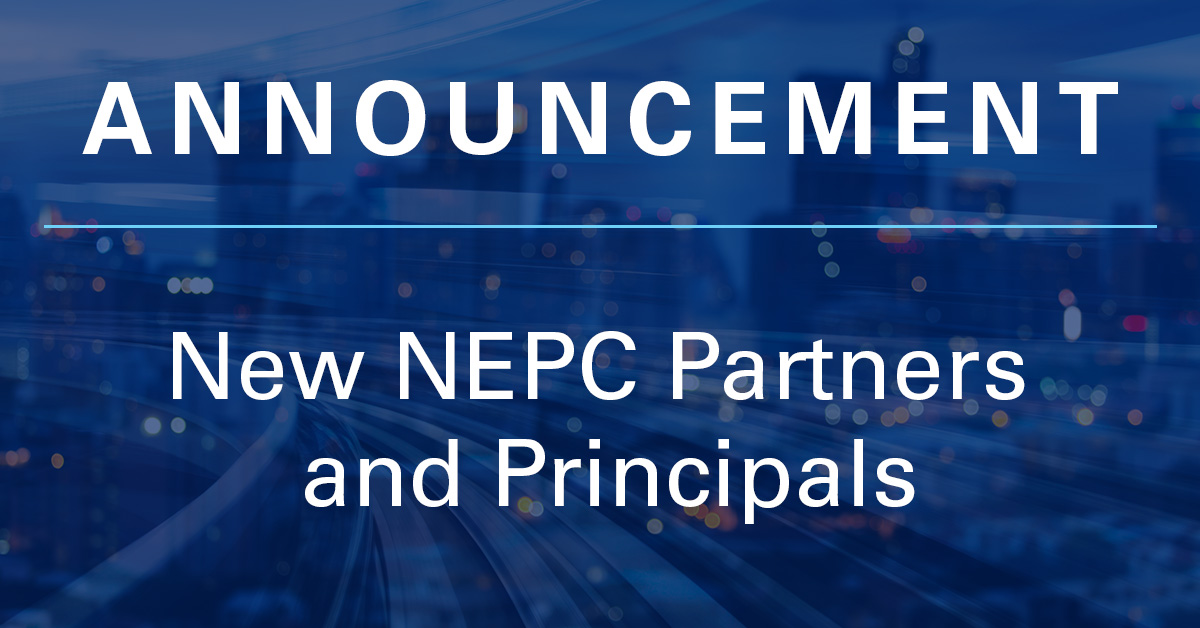Reuters: Stocks Surge, Bond Yields Slip Ahead of Fed Decision
NEPC’s Phillip Nelson was quoted in a recent Reuters article to discuss the firm’s stance on the market’s take on interest rates. View the article on Reuters’ site here.
NEW YORK/LONDON, Jan 29 (Reuters) – Global stocks surged on Monday, with the S&P 500 closing at a new record close and European shares hitting a two-year high, as markets slashed ambitious bets at the end of 2023 on interest rate cuts by the Federal Reserve and other central banks.
. . .
The Wall Street Journal: There’s a New Option in Your 401(k). Read This Before You Try It.
Bill Ryan, Head of Defined Contribution Solutions at NEPC, sat down with The Wall Street Journal to discuss why bespoke retirement plans, such as managed accounts, are not always worth the additional cost. View the article on The Wall Street Journal’s site here.
What’s the best option for your 401(k), one-size-fits-all or a custom fit?
Most of us go with the one-size-fits-all option, putting our retirement savings in target-date funds built to maximize returns based on our timelines for retirement. A growing number of people, however, are choosing the custom fit in the form of managed accounts, which seek to tailor investment portfolios and advice to their situations.
As with clothing, the custom option will cost you. What investors have to determine is whether a managed account merits the price.
. . .
Only about 15% of people in managed accounts typically provide the information needed to personalize their portfolios, said Bill Ryan, head of defined contribution solutions at NEPC. Without data on factors including risk tolerance and outside account balances, people mightmiss out on the potential for extra value that they are paying for, he added.
A small fraction of employers auto-enroll workers in managed accounts, but most plans that offer them leave it up to savers to choose to sign up. Most 401(k) plans offer only one managed account service, making it impossible for employees to comparison shop.
Click here to continue reading the full Wall Street Journal article.
Chief Investment Officer: Public Equities Drove University Endowment Returns in 2023
NEPC’s mega-endowments white paper data was recently featured in an article to discuss what caused many smaller universities to outperform larger university endowments in 2023. View the full article on Chief Investment Officer’s site here.
What allowed the U.C. San Diego Foundation to outperform all of its university endowment peers last year? Its equity-heavy portfolio.
The $1.4 billion university endowment for the University of California, San Diego returned 11.3% in fiscal year 2023, which ended June 30, 2023, the highest reported return of any endowment with more than $1 billion in assets for the period, according to data tracked by NEPC LLC.
. . .
Of the 62 endowments with assets of more than $1 billion tracked by NEPC, six had negative returns in fiscal year 2023. The University of North Carolina, Duke University, Princeton University, Vanderbilt University, Washington University St. Louis and MIT endowments returned losses of 0.4%, 1.0%, 1.7%, 2.0%, 2.3%, and 2.9%, respectively.
What united these funds was their very high allocations to alternative investments, which generally underperformed other asset classes in the fiscal year, most notably private equity.
Click here to read the full interview on Chief Investment Officer’s site.
Chief Investment Officer: Investors’ Interest Rate Expectations Unrealistic, per NEPC
NEPC’s Phillip Nelson and Tim McCusker were recently quoted in an article to discuss how after many years of low borrowing costs, too many people have the delusion that these will return. View the full article on Chief Investment Officer’s site here.
To many investors, it is back to normal for interest rates, meaning they expect the sunny days of low single digits will return soon. Consulting firm NEPC begs to differ.
. . .
The Fed, which had jacked up interest rates to combat the inflationary surge, thinks the mission is accomplished and is talking about lowering its benchmark federal funds rate from its current band of 5.25% to 5.50%. Many investors are applauding, expecting lower rates to further juice the stock market.
That buoyant scenario is simply not likely, according to an NEPC webinar on Thursday. A lot of people “are anchored to low inflation,” said Phillip Nelson, the consulting firm’s head of asset allocation. As a result, “the market is biased toward low rates.”
. . .
Meanwhile, in a related delusion, NEPC’s strategists contended that investors remain besotted by the stock market’s bullish performance and believe more is on the way.
Trouble is, noted Tim McCusker, NEPC’s CIO, the S&P 500’s recent rise has merely recovered ground lost in the 2022 slump. The index’s new peak level set on Thursday, of 4,894.16, was just slightly more than the January 3, 2022, apex of 4,796.56. Thus, he said, “This has been a round trip.”
FundFire: Corporate Pensions Try to Protect Funded Status amid Market Uncertainty
NEPC’s Jake Mallinson was quoted in a recent FundFire article to discuss where most defined benefit plan investors plan to allocate their assets, according to our latest Defined Benefit Trends Survey. View the article on FundFire’s site here.
Corporate pensions are prioritizing funded status protection rather than return maximization amid fears of a market downturn, according to a report published by NEPC in November.
The consulting firm interviewed 51 companies and healthcare organizations with defined benefit plans ranging from $100 million to more than $300 billion in size about their market sentiment and liability-driven investments, or LDI.
. . .
“The increase in fixed income returns, especially for defined benefit plans that have large allocations to fixed income, saw that big jump in expected return on assets,” said Jake Mallinson, a consultant at NEPC.
. . .
Long duration corporate or Treasury bonds are the most popular LDI instruments, according to the report.
“That shift in investing is really looking to de-risk the portfolio over time and lock in those funded status gains,” Mallinson said.
Read the full article on FundFire’s website here.
Celebrating Growth: NEPC Announces New 2024 Partners and Principals
BOSTON–December 6, 2023—NEPC, LLC one of the industry’s largest independent, research-driven investment consulting firms, today announced the election of six new partners and the promotion of five new principals across the firm. These new elections and promotions will be effective January 1, 2024.
2023 has seen strong growth for NEPC and its client portfolios. These new promotions highlight NEPC’s commitment to cultivating an experienced team across the firm that clients can trust will help them achieve their long-term goals.
“NEPC takes immense pride in nurturing and empowering our exceptional talent,” said Michael Manning, Managing Partner of NEPC. “It’s an honor to watch our team grow within the firm and also to bring in fresh perspectives.
The newly elected Partners are:
- Rick Ciccione, Senior Consultant
- Rose Dean, CFA, Senior Consultant
- Oliver Fadly, Head of Private Debt Investments
- Joe Nankof, ASA, Senior Consultant
- Deirdre Robert, CFA, CAIA, Senior Consultant
- Daniel Runnals, CFA, CAIA, Senior Consultant
NEPC’s new Principals are:
- David Barnes, CFA, CAIA, Senior Consultant
- Peggy Boraks, Senior Controller
- Aaron Chastain, CFA, Senior Consultant
- Nick Mann, Senior Investment Director, Private Markets
- Emma O’Brien, Senior Consultant
Manning also stated, “These well-deserved appointments are a testament to our culture and core beliefs of elevating the experience and value we bring to the table to provide our clients with best-in-class solutions.”
For more information on NEPC’s employee workforce and to explore open opportunities, click here.
About NEPC, LLC
NEPC is an independent investment consultant, private wealth advisor, and OCIO provider serving over 400 retainer clients and $1.6 trillion in total assets. Combining a proprietary research team dedicated to the long-term challenges facing investors with our unique client-centric model, NEPC builds forward-looking investment portfolios for institutional investors and ultra-high-net-worth individuals. To learn more about NEPC, visit nepc.com.
Media Contact:
Laura Nascimento
WSJ Pro: Oil Prices Could Disrupt Soft Landing for U.S. Economy
NEPC’s Phillip Nelson, Director of Asset Allocation, sat down with WSJ Pro to discuss energy prices in the U.S. economic outlook. View the article on WSJ Pro’s site here.
Energy prices are a wild card in the U.S. economic outlook, says Phillip Nelson, director asset allocation at NEPC.
. . .
“…A spike in oil prices, possibly triggered by a flare-up of geopolitical tensions, could create “another challenging dynamic,” with higher inflation and weaker economy, he says. Nelson adds that the upcoming presidential election is likely to have a “minor influence” on NEPC’s outlook. “I think whether it’s looking at President Biden or Mr. Trump, we know what their policies are,” he says.”
Business Insider: Scott Shleifer Steered Billions Into Startups for Tiger Global. With His Reign Now Over, the Industry Wonders What's Next.
NEPC’s Sarah Samuels was quoted in a recent Business Insider article which focuses on the stepdown of Tiger Global executive Scott Shleifer and the overarching trend of succession planning. View the article on Business Insider’s site here.
Billionaire Scott Shleifer stepped down from his role leading Tiger Global’s private investing unit.
The firm has been accused of fostering a “bro culture” that led to a $10 million settlement. Many of Tiger’s private bets have struggled thanks to rising interest rates and a global slowdown.
. . .
“Succession risk in alternative funds is much more acute in private market strategies since they’re less liquid, said Sarah Samuels, head of investment manager research for NEPC, which advises more than $1 trillion of institutional capital on which funds to back.
“Institutions are comprised of people, and they change,” said Samuels, speaking generally about leadership changes at investment managers. Typical hiccups for leadership transitions include “a lack of proactiveness and transparency,” she said.”
Click here to continue reading the full Business Insider article.
FIN News: Q3: Institutions Seek Opportunistic Strategies In Uncertain, High Rate Environment
NEPC’s Shelley Santulli and Colton Lavin were recently featured in FIN News to discuss recent upticks in commitments to opportunistic strategies, as well as an increase in the number of different vehicle structures that private debt managers are using. Excerpts from the article are shown below. View the article in it’s entirety on FIN News’ site here.
Institutional investors have become increasingly attracted to opportunistic and special situations investments across the broad real estate and credit sectors due to interest rate hikes and capital market dislocation, which the industry finds will likely continue into 2024.
. . .
“Investment consultant NEPC was tied to many of the mandates made in the space last quarter and the firm has seen an uptick of commitments into opportunistic strategies as well as an increase in the number of different vehicle structures that private debt managers are using.
“Looking at those commitments, they’ve tended to be more in the corporate or public pension plan category, but there have also been some endowment and foundation commitments as well. As the market opportunity set is still evolving, we do expect clients to continue to make opportunistic commitments in 2024,” Principal and Senior Investment Director of Real Assets Shelley Santulli said.”
. . .
“NEPC has seen increased interest in opportunistic strategies dating back to the initial onset of the pandemic, according to Investment Director of Private Debt Colton Lavin.
“There were some interesting investment opportunities that arose for only a couple of weeks before dissipating. Many investors were at the time under allocated to opportunistic strategies because of the relatively benign credit environment that they have been experiencing over the previous decade. So, they missed out on those unique opportunities because they couldn’t move quickly enough to capitalize. Investors have since aimed to potentially avoid missing out again by preemptively allocating within the opportunistic private debt space now,” he said.”
. . .
“NEPC does not find the increased interest and hires surprising either and Santulli made note that interest in real estate opportunistic strategies is a result of capital market dislocation.
“The sharp rise in interest rates during 2022 and 2023 has disrupted real estate capital markets and is putting stress on capital structures, leverage, cash flow properties and property valuations, which have been adjusting downward as a result. This is creating areas of distress across the sector, which is slowly coming to the surface. It is most acute in the office sector, where property fundamentals are the weakest. Most of the market opportunity relates to the rapid rise in interest rates and the consequential valuation reset as real estate is largely a leveraged asset class,” she said.”
. . .
“As new strategies and offerings keep coming to market, the universe of funds under the opportunistic categorization continues to expand, representing one contributing factor for the increased focus on the space from investors, according to Lavin.
“During uncertain volatile market environments like we’ve been experiencing, the window for attractive opportunity sets may come and go over a relatively short time horizon. Some strategies within opportunistic credit may have flexible mandates that allow the fund to invest in a variety of different types of credit in public or private markets, and/or in different geographies. This allows GPs to canvas the market more broadly, make relative value decisions regarding where they believe they can achieve the best possible risk-adjusted returns as opposed to being siloed to a specific or narrow opportunity set that may or may not be in favor at any given point in time. Some investors have found this to be a compelling proposition in the current environment,” he said.”
. . .
“Several different types of strategies can fall under the opportunistic private credit or private debt classification, according to NEPC’s Lavin, who has covered private debt for eight years, however the benefit to an institution’s portfolio will largely be dependent on the specific fund they invest in and strategies will range anywhere from being more income-oriented to more appreciation-oriented.
“Depending on the mandate, certain funds may experience enhanced tailwinds when the broader economy falters [and] those sorts of offerings can serve somewhat as a hedge against a market downturn. Other types of opportunistic strategies may provide investors with diversification through targeting exposure to borrowers and or collateral that have less correlation with major economic indices. And then another potential benefit of investing in opportunistic private debt could be return enhancement, as funds will aim to achieve a return premium relative to both public market debt and also more conservative private debt strategies. Funds seek to generate these higher returns through charging borrowers, higher spreads and/or through capital appreciation,” he said.”
. . .
“While opportunistic strategies within real estate can provide more alpha and higher returns, NEPC’s Santulli, who joined the firm’s investment research group roughly one year ago after having worked at various investment positions at real estate investment management firms over her more than 30-year career, indicated that these strategies generally have more appreciation relative to income and made note of other benefits.
“Opportunistic or special situation strategies can have a variety of investment structures, including equity, preferred equity, providing more downside protection, or even debt, including performing and non-performing no purchases,” she said, adding that diversification is important for risk mitigation within any institutional portfolio.
“Most investors will have a balance of core and non-core real estate and equity and credit across asset classes. The added benefit of real estate is that it can provide a partial hedge against inflation, particularly for property sectors with shorter-term leases, such as hospitality, residential and self-storage. Although supply and demand fundamentals are often stronger influencers and the ability to increase rental rates in the current environment of higher inflation, real estate can be attractive as an asset class for investment,” she said.”
. . .
“NEPC advises its clients not to try and time the market when managing a private market portfolio as market timing is not a prerequisite for investors to find opportunistic strategies compelling, Lavin said, adding that investors should further maintain consistent deployment to ensure vintage year diversification.
“They’re not necessarily reliant upon a specific economic environment or point in time in order to generate deal flow and subsequently, returns. Those types of strategies are meant to be all weather,” he said.”
. . .
“As indicated by her industry peers, Santulli made note that higher risk comes with opportunistic strategies, but in the current environment with market dislocation, attractive returns can be produced.
“Some of the best vintage years for opportunistic strategies are during periods of market disruption like we’re witnessing right now. NEPC has been targeting opportunistic strategies for real estate during 2023 to capitalize on evolving market distress, and has been recommending them to clients that have a higher risk tolerance, and are seeking a higher return profile. Clients that are more income focused with a more defensive posture are being advised to consider real estate debt funds where they can achieve an attractive, risk-adjusted return with a much higher income component and much less risk,” she said.”
. . .
“Real estate debt funds have been another area of focus for NEPC and provide a more defensive strategy with higher income potential.
“Given the level of current base rates, real estate debt can provide higher returns than in the recent past, where interest rates were quite low. With traditional lenders more on the sidelines, real estate debt funds also have a greater market opportunity, and underwriting standards are more conservative along with more lender-friendly loan terms. So, there’s greater equity subordination protecting these debt investments against any downside risk, and, unlike in the recent past, you can achieve a very attractive return profile somewhere in the low to mid-teens,” Santulli said.
Private debt secondaries is an emerging space and a “relatively niche asset class,” according to Lavin, who stated that many funds that have been raised have not reached the stage of maturity where material secondary transactions would be more likely to occur.
“We’re seeing a couple of interesting dynamics that play that may lead to an expanded secondary opportunity set within private debt. We’re seeing LPs evaluate their existing portfolios and consider selling their stakes and funds in order to generate or maintain liquidity for several different reasons. GPs are looking for additional capital in order to continue investing in and supporting their portfolio companies. Because of these potential tailwinds, we’re seeing an increase in the number of asset managers in general seeking to raise dedicated pools of capital to target secondary opportunities within private debt,” he said.
NEPC has also been focused on real estate secondaries during 2023 and will continue to focus on that in 2024, according to Santulli.
“Real estate secondaries currently have deeper discounts, and the volume is increasing. So, we do see a very good market opportunity for clients here. From what we’ve seen to date, GP-led secondaries have been more dominant so far in 2023, but LP-led secondaries are also available and attractive. We like secondary strategies due to the discounted basis that you can achieve, and the limited J Curve as investments are generally further along in their business strategies,” she said.”
. . .
“Overall, the industry advises investors to take advantage of investment now and in the coming quarters in the opportunistic real estate and credit spaces, but also stressed that institutions should make the effort to really focus on manager selection.
If the past is any guide to the future, 2023 and 2024 are expected to be excellent vintage years for real estate opportunistic and special situation strategies, Santulli noted.
“I’ve been through multiple cycles, and the current market environment is one where these strategies can thrive particularly with experienced managers that have executed well in prior cycles,” she said.
Investors should have heightened focus on manager selection when dealing with strategies such as opportunistic private debt that are prone to a wider dispersion of returns amongst the cohort of funds in the space, according to Lavin, who implied that regardless of the market environment, poor business management is not cyclical.
“There will always be underperforming companies that could benefit from the solutions that are provided by opportunistic and private debt funds,” he said.
“We expect continued interest throughout 2024 and in the current market environment there will be greater return dispersion and skilled experienced managers will break away from the crowd. The key in identifying the best strategies in managers will be very important. We’re very hyper-focused on the best managers that are positioned to outperform in this type of environment and this type of cycle,” Santulli said.”
Pensions & Investments: Corporate Plans Keeping Eye on Funded Status, NEPC Survey Says
NEPC’s Jake Mallinson was quoted in a recent Pensions & Investments article that covers NEPC’s 2023 Defined Benefit survey to discuss why higher rates and inflation are actually good news for funded status and frozen plans. View the article on Pensions & Investments’ site here.
U.S. corporate DB plans continue to see their funding ratios improve and remain focused on funded status, a survey from NEPC indicated.
. . .
“It pays to be a saver,” said Jake Mallinson, consultant with NEPC’s defined benefit team, in a Nov. 9 news release. “Higher rates and higher inflation are typically good news for funded status and frozen plans, as higher discount rates reduce the value of liabilities. While equity valuations are down, forward-looking return assumptions (especially for fixed income investments) fare better.”
Click here to continue reading the full Pensions & Investments article.









